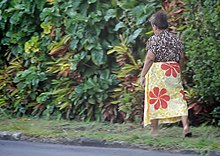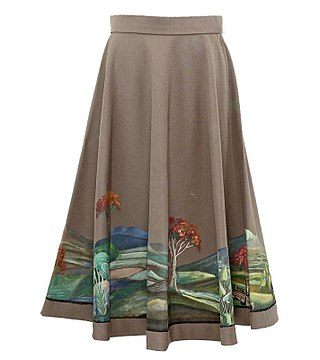
A skirt is the lower part of a dress or a separate outer garment that covers a person from the waist downwards.

Hula is a Hawaiian dance form expressing chant (oli) or song (mele). It was developed in the Hawaiian Islands by the Native Hawaiians who settled there. The hula dramatizes or portrays the words of the oli or mele in a visual dance form.

A folk costume expresses a national identity through clothing or costume, which is usually associated with a specific region or period of time in history. It can also indicate social, marital, or religious status. If the costume is used to represent the culture or identity of a specific ethnic group, it is usually known as ethnic costume. Such costumes often come in two forms: one for everyday occasions, the other for traditional festivals and formal wear. The word "costume" in this context is sometimes considered pejorative due to the multiple senses of the word, and in such cases "clothing", "garments" or "regalia" can be substituted without offense.

A sarong or a sarung is a large tube or length of fabric, often wrapped around the waist, worn in Southeast Asia, South Asia, Western Asia, Northern Africa, East Africa, West Africa, and on many Pacific islands. The fabric often has woven plaid or checkered patterns, or may be brightly colored by means of batik or ikat dyeing. Many modern sarongs have printed designs, often depicting animals or plants. Different types of sarongs are worn in different places in the world, notably the lungi in the Indian subcontinent and the izaar in the Arabian Peninsula.
The traditional culture of Samoa is a communal way of life based on Fa'a Samoa, the unique socio-political culture. In Samoan culture, most activities are done together. The traditional living quarters, or fale (houses), contain no walls and up to 20 people may sleep on the ground in the same fale. During the day, the fale is used for chatting and relaxing. One's family is viewed as an integral part of a person's life. The aiga or extended family lives and works together. Elders in the family are greatly respected and hold the highest status, and this may be seen at a traditional Sunday umu.
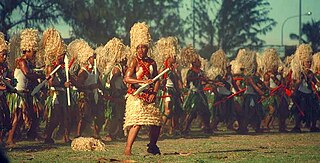
The Tongan archipelago has been inhabited for perhaps 3,000 years, since settlement in late Lapita times. The culture of its inhabitants has surely changed greatly over this long time period. Before the arrival of European explorers in the late 17th and early 18th centuries, the Tongans were in frequent contact with their nearest Oceanic neighbors, Fiji and Samoa. In the 19th century, with the arrival of Western traders and missionaries, Tongan culture changed dramatically. Some old beliefs and habits were thrown away and others adopted. Some accommodations made in the 19th century and early 20th century are now being challenged by changing Western civilization. Hence Tongan culture is far from a unified or monolithic affair, and Tongans themselves may differ strongly as to what it is "Tongan" to do, or not do. Contemporary Tongans often have strong ties to overseas lands. They may have been migrant workers in New Zealand, or have lived and traveled in New Zealand, Australia, or the United States. Many Tongans now live overseas, in a Tongan diaspora, and send home remittances to family members who prefer to remain in Tonga. Tongans themselves often have to operate in two different contexts, which they often call anga fakatonga, the traditional Tongan way, and anga fakapālangi, the Western way. A culturally adept Tongan learns both sets of rules and when to switch between them.
The culture of Fiji is a tapestry of native Fijian, Indian, European, Chinese, and other nationalities. Culture polity traditions, language, food costume, belief system, architecture, arts, craft, music, dance, and sports will be discussed in this article to give you an indication of Fiji's indigenous community but also the various communities which make up Fiji as a modern culture and living. The indigenous culture is an active and living part of everyday life for the majority of the population.

Tupenu is the Tongan term for a wrapped garment also called a sarong, lungi, or lava-lava, worn through much of South Asia, Southeast Asia, Arabian peninsula, the Horn of Africa and Oceania. It is analogous to the kilt worn in Scotland.

Tapa cloth is a barkcloth made in the islands of the Pacific Ocean, primarily in Tonga, Samoa and Fiji, but as far afield as Niue, Cook Islands, Futuna, Solomon Islands, Java, New Zealand, Vanuatu, Papua New Guinea and Hawaii. In French Polynesia it has nearly disappeared, except for some villages in the Marquesas.

The puletasi (Samoa) or puletaha (Tonga) is a traditional item of clothing worn by Samoan, Tongan, and Fijian women and girls. Today, puletasi is used as a female full dress. It is most commonly worn to church and formal cultural events.

The Tuʻi Tonga Empire, or Tongan Empire, are descriptions sometimes given to Tongan expansionism and projected hegemony in Oceania which began around 950 CE, reaching its peak during the period 1200–1500.
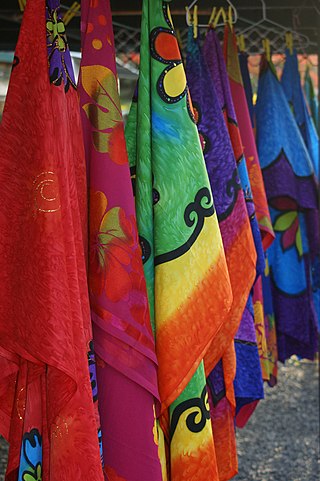
A pāreu or pareo is a wraparound skirt worn on Tahiti or other Pacific islands. The term was originally used only for women's skirts, as men wore a loincloth, called a maro. Nowadays the term is used for any cloth worn wrapped around the body by men and women.
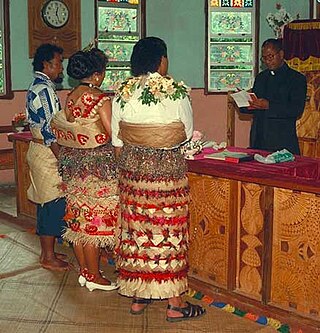
A taʻovala is an article of Tongan dress, a mat wrapped around the waist, worn by men and women, at all formal occasions, much like the tie for men in the Western culture. The ta'ovala is also commonly seen among the Fijian Lau Islands, and Wallis island, both regions once heavily influenced by Tongan hegemony and cultural diffusion.
Pacific Islander Americans are Americans who are of Pacific Islander ancestry. For its purposes, the United States census also counts Aboriginal Australians as part of this group.

A grass skirt is a costume and garment made with layers of plant fibres such as grasses and leaves that is fastened at the waistline.

An ʻie tōga is a special finely woven mat that is an important item of cultural value in Samoa. They are commonly referred to in English as "fine mats" although they are never used as mats as they only have a purely cultural value. ʻIe tōga are valued by the quality of the weave and the softness and shine of the material. They are made by women and form an important part of their role, identity and skill in their community.

The Peʻa is the popular name of the traditional male tatau (tattoo) of Samoa, also known as the malofie. It is a common mistake for people to refer to the pe'a as sogaimiti, because sogaimiti refers to the man with the pe'a and not the pe'a itself. It covers the body from the middle of the back to the knees, and consists of heavy black lines, arrows, and dots.
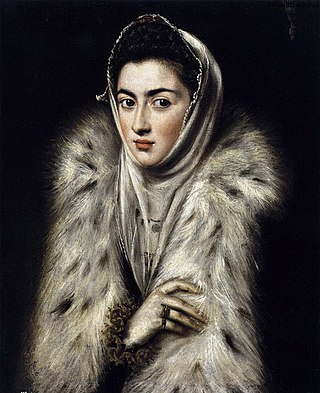
In the context of clothing, a wrap can refer to a shawl or stole or other fabric wrapped about the upper body, or a simple skirt-type garment made by wrapping a piece of material round the lower body. Many people of all genders throughout the world wear wraps in everyday life, although in the West they are largely worn by women. They are sometimes sewn at the edges to form a tube which keeps the required size. A wrap may be secured by a corner being tucked beneath the wrapped material, by making a knot, or using ties, buttons or velcro.
The Taualuga is a traditional Samoan dance, considered the apex of Samoan performance art forms and the centerpiece of the Culture of Samoa. This dance form has been adopted and adapted throughout western Polynesia, most notably in Samoa, The Kingdom of Tonga, Uvea, Futuna, and Tokelau. The renowned Tongan version is called the tau'olunga.

